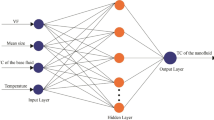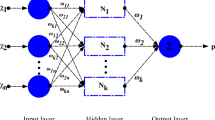Abstract
Nanofluids are widely applicable in thermal devices with porous structures. Silica nanoparticles have been dispersed in different heat transfer fluids in order to increase their thermal conductivity and heat transfer capability. In this study, group method of data handling (GMDH) and multilayer perceptron artificial neural networks are applied for determining thermal conductivity of nanofluids with silica particles and different base fluids such as ethylene glycol, glycerol, water and ethylene glycol–water mixture. For cases with multilayer perceptron models, trained by applying scaled conjugate gradient (SCG) and Levenberg–Marquardt (LM) have been tested as two different training algorithms. The outputs of the applied models have good agreement with the values obtained in experimental studies. The values of \({R}^{2}\) in the optimum conditions of using GMDH, LM and SCG are 0.9997, 0.9991 and 0.9998, respectively. In addition, the MSE values of the mentioned methods are approximately 0.000010, 0.000032 and 0.0000078, respectively.







Similar content being viewed by others
References
Gandomkar A, Kalan K, Vandadi M, Shafii MB, Saidi MH. Investigation and visualization of surfactant effect on flow pattern and performance of pulsating heat pipe. J Therm Anal Calorim. 2019. https://doi.org/10.1007/s10973-019-08649-z.
Alizadeh H, Ghasempour R, Shafii MB, Ahmadi MH, Yan W-M, Nazari MA. Numerical simulation of PV cooling by using single turn pulsating heat pipe. Int J Heat Mass Transf. 2018;127:203–8.
Toghyani S, Afshari E, Baniasadi E, Shadloo MS. Energy and exergy analyses of a nanofluid based solar cooling and hydrogen production combined system. Renew Energy. 2019;141:1013–25.
Karimipour A, Bagherzadeh SA, Goodarzi M, Alnaqi AA, Bahiraei M, Safaei MR, et al. Synthesized CuFe2O4/SiO2 nanocomposites added to water/EG: evaluation of the thermophysical properties beside sensitivity analysis & EANN. Int J Heat Mass Transf. 2018;127:1169–79.
Sørensen DN, Voigt LK. Modelling flow and heat transfer around a seated human body by computational fluid dynamics. Build Environ. 2003;38:753–62.
De Dear RJ, Arens E, Hui Z, Oguro M. Convective and radiative heat transfer coefficients for individual human body segments. Int J Biometeorol. 1997;40:141–56.
Ghanami S, Farhadi M. Heat transfer enhancement in a single-pipe heat exchanger with fluidic oscillators. J Therm Anal Calorim. 2019;1–13.
Arasteh H, Mashayekhi R, Ghaneifar M, Toghraie D, Afrand M. Heat transfer enhancement in a counter-flow sinusoidal parallel-plate heat exchanger partially filled with porous media using metal foam in the channels’ divergent sections. J Therm Anal Calorim. 2019;1–17.
Hasanpour B, Irandoost MS, Hassani M, Kouhikamali R. Numerical investigation of saturated upward flow boiling of water in a vertical tube using VOF model: effect of different boundary conditions. Heat Mass Transf Stoffuebertragung. 2018;54:1925–36.
Gholamalipour P, Siavashi M, Doranehgard MH. Eccentricity effects of heat source inside a porous annulus on the natural convection heat transfer and entropy generation of Cu-water nanofluid. Int Commun Heat Mass Transf. 2019;109:104367.
Ramezanizadeh M, Alhuyi Nazari M, Hossein Ahmadi M, Chen L. A review on the approaches applied for cooling fuel cells. Int J Heat Mass Transf. 2019;139:517–25.
Abdollahzadeh Jamalabadi M, Ghasemi M, Alamian R, Wongwises S, Afrand M, Shadloo M. Modeling of subcooled flow boiling with nanoparticles under the influence of a magnetic field. Symmetry. 2019;11:1275. https://www.mdpi.com/2073-8994/11/10/1275
Choi SUS, Eastman JA. Enhancing thermal conductivity of fluids with nanoparticles. ASME international mechanical engineering congress & exposition. American Society of Mechanical Engineers, San Francisco, 1995.
Gandomkar A, Saidi MH, Shafii MB, Vandadi M, Kalan K. Visualization and comparative investigations of pulsating ferro-fluid heat pipe. Appl Therm Eng. 2017;116:56–655.
Heydarian R, Shafii MB, Rezaee Shirin-Abadi A, Ghasempour R, Alhuyi Nazari M. Experimental investigation of paraffin nano-encapsulated phase change material on heat transfer enhancement of pulsating heat pipe. J Therm Anal Calorim. 2019;137:1603–13. https://doi.org/10.1007/s10973-019-08062-6.
Ajeel RK, Salim WSI, Sopian K, Yusoff MZ, Hasnan K, Ibrahim A, et al. Turbulent convective heat transfer of silica oxide nanofluid through corrugated channels: An experimental and numerical study. Int J Heat Mass Transf. 2019;145:118806.
Qi C, Luo T, Liu M, Fan F, Yan Y. Experimental study on the flow and heat transfer characteristics of nanofluids in double-tube heat exchangers based on thermal efficiency assessment. Energy Convers Manag. 2019;197:111877.
Safaei MR, Togun H, Vafai K, Kazi SN, Badarudin A. Investigation of heat transfer enhancement in a forward-facing contracting channel using FMWCNT nanofluids. Numer Heat Transf A Appl. 2014;66:1321–40.
Byrne MD, Hart RA, Da Silva AK. Experimental thermal-hydraulic evaluation of CuO nanofluids in microchannels at various concentrations with and without suspension enhancers. Int J Heat Mass Transf. 2012;55:2684–91.
Kalteh M, Abbassi A, Saffar-Avval M, Frijns A, Darhuber A, Harting J. Experimental and numerical investigation of nanofluid forced convection inside a wide microchannel heat sink. Appl Therm Eng. 2012;36:260–8.
Behnampour A, Akbari OA, Safaei MR, Ghavami M, Marzban A, Sheikh Shabani GA, et al. Analysis of heat transfer and nanofluid fluid flow in microchannels with trapezoidal, rectangular and triangular shaped ribs. Phys E Low-Dimens Syst Nanostruct. 2017;91:15–311.
Irandoost Shahrestani M, Maleki A, Safdari Shadloo M, Tlili I. Numerical investigation of forced convective heat transfer and performance evaluation criterion of Al2O3/water nanofluid flow inside an axisymmetric microchannel. Symmetry 2020;12:120. https://www.mdpi.com/2073-8994/12/1/120
Kalteh M. Investigating the effect of various nanoparticle and base liquid types on the nanofluids heat and fluid flow in a microchannel. Appl Math Model. 2013;37:8600–9.
Mohammed HA, Gunnasegaran P, Shuaib NH. The impact of various nanofluid types on triangular microchannels heat sink cooling performance. Int Commun Heat Mass Transf. 2011;38:767–73.
Bayat J, Nikseresht AH. Investigation of the different base fluid effects on the nanofluids heat transfer and pressure drop. Heat Mass Transf Stoffuebertragung. 2011;47:1089–99.
Siavashi M, Karimi K, Xiong Q, Doranehgard MH. Numerical analysis of mixed convection of two-phase non-Newtonian nanofluid flow inside a partially porous square enclosure with a rotating cylinder. J Therm Anal Calorim. 2019;137:267–87.
Joibary SMM, Siavashi M. Effect of Reynolds asymmetry and use of porous media in the counterflow double-pipe heat exchanger for passive heat transfer enhancement. J Therm Anal Calorim. 2019;1–15.
Siavashi M, Talesh Bahrami HR, Aminian E, Saffari H. Numerical analysis on forced convection enhancement in an annulus using porous ribs and nanoparticle addition to base fluid. J Cent South Univ. 2019;26:1089–98.
Bagherzadeh SA, Sulgani MT, Nikkhah V, Bahrami M, Karimipour A, Jiang Y. Minimize pressure drop and maximize heat transfer coefficient by the new proposed multi-objective optimization/statistical model composed of “ANN + Genetic Algorithm” based on empirical data of CuO/paraffin nanofluid in a pipe. Phys A Stat Mech Appl. 2019;527:121056.
Ramezanizadeh M, Ahmadi MA, Ahmadi MH, Alhuyi Nazari M. Rigorous smart model for predicting dynamic viscosity of Al2O3/water nanofluid. J Therm Anal Calorim. 2018. https://doi.org/10.1007/s10973-018-7916-1.
Wang N, Maleki A, Alhuyi Nazari M, Tlili I, Safdari Shadloo MS. Thermal conductivity modeling of nanofluids contain MgO particles by employing different approaches. Symmetry. 2020;12(2):206.
Ahmadi MH, Mirlohi A, Alhuyi Nazari M, Ghasempour R. A review of thermal conductivity of various nanofluids. J Mol Liq. 2018;265:181–8.
Yıldız Ç, Arıcı M, Karabay H. Comparison of a theoretical and experimental thermal conductivity model on the heat transfer performance of Al2O3–SiO2/water hybrid-nanofluid. Int J Heat Mass Transf. 2019;140:598–605.
Shamaeil M, Firouzi M, Fakhar A. The effects of temperature and volume fraction on the thermal conductivity of functionalized DWCNTs/ethylene glycol nanofluid. J Therm Anal Calorim. 2016;126:1455–62. https://doi.org/10.1007/s10973-016-5548-x.
Cacua K, Murshed SMS, Pabón E, Buitrago R. Dispersion and thermal conductivity of TiO2/water nanofluid. J Therm Anal Calorim. 2019;1–6.
Ramezanizadeh M, Alhuyi NM. Modeling thermal conductivity of Ag/water nanofluid by applying a mathematical correlation and artificial neural network. Int J Low-Carbon Technol. 2019. https://doi.org/10.1093/ijlct/ctz030/5552090.
Hemmat EM. Designing an artificial neural network using radial basis function (RBF-ANN) to model thermal conductivity of ethylene glycol–water-based TiO2nanofluids. J Therm Anal Calorim. 2017;127:2125–31.
Hemmat Esfe M, Naderi A, Akbari M, Afrand M, Karimipour A. Evaluation of thermal conductivity of COOH-functionalized MWCNTs/water via temperature and solid volume fraction by using experimental data and ANN methods. J Therm Anal Calorim. 2015;121:1273–8.
Hemmat Esfe M, Wongwises S, Naderi A, Asadi A, Safaei MR, Rostamian H, et al. Thermal conductivity of Cu/TiO2–water/EG hybrid nanofluid: experimental data and modeling using artificial neural network and correlation. Int Commun Heat Mass Transf. 2015;66:100–4.
Nabipour N, Daneshfar R, Rezvanjou O, Mohammadi-Khanaposhtani M, Baghban A, Xiong Q, et al. Estimating biofuel density via a soft computing approach based on intermolecular interactions. Renew Energy. 2020;152:1086–98.
Ramezanizadeh M, Alhuyi Nazari M, Ahmadi MH, Lorenzini G, Pop I. A review on the applications of intelligence methods in predicting thermal conductivity of nanofluids. J Therm Anal Calorim. 2019. https://doi.org/10.1007/s10973-019-08154-3.
Ramezanizadeh M, Ahmadi MH, Nazari MA, Sadeghzadeh M, Chen L. A review on the utilized machine learning approaches for modeling the dynamic viscosity of nanofluids. Renew Sustain Energy Rev. 2019;114:109345.
Komeilibirjandi A, Raffiee AH, Maleki A, Alhuyi Nazari M, Safdari Shadloo M. Thermal conductivity prediction of nanofluids containing CuO nanoparticles by using correlation and artificial neural network. J Therm Anal Calorim. 2019. https://doi.org/10.1007/s10973-019-08838-w.
Vafaei M, Afrand M, Sina N, Kalbasi R, Sourani F, Teimouri H. Evaluation of thermal conductivity of MgO-MWCNTs/EG hybrid nanofluids based on experimental data by selecting optimal artificial neural networks. Phys E Low-Dimens Syst Nanostruct. 2017;85:90–6. https://doi.org/10.1016/j.physe.2016.08.020.
Pourkiaei SM, Ahmadi MH, Hasheminejad SM. Modeling and experimental verification of a 25W fabricated PEM fuel cell by parametric and GMDH-type neural network. Mech Ind. 2016;17:105. https://doi.org/10.1051/meca/2015050.
Kasaeian A, Ghalamchi M, Ahmadi MH, Ghalamchi M. GMDH algorithm for modeling the outlet temperatures of a solar chimney based on the ambient temperature. Mech Ind. 2017;18:216. https://doi.org/10.1051/meca/2016034.
Ahmadi MH, Sadeghzadeh M, Raffiee AH, Chau K. Applying GMDH neural network to estimate the thermal resistance and thermal conductivity of pulsating heat pipes. Eng Appl Comput Fluid Mech. 2019;13:327–36. https://doi.org/10.1080/19942060.2019.1582109.
Mohamadian F, Eftekhar L, Haghighi Bardineh Y. Applying GMDH artificial neural network to predict dynamic viscosity of an antimicrobial nanofluid. Mashhad Univ Med Sci Nanomed J. 2018;5:217–21. https://nmj.mums.ac.ir/article_11600.html
Akilu S, Baheta AT, Minea AA, Sharma KV. Rheology and thermal conductivity of non-porous silica (SiO2) in viscous glycerol and ethylene glycol based nanofluids. Int Commun Heat Mass Transf. 2017;88:245–53.
Esfahani MA, Toghraie D. Experimental investigation for developing a new model for the thermal conductivity of silica/water-ethylene glycol (40%–60%) nanofluid at different temperatures and solid volume fractions. J Mol Liq. 2017;232:105–12.
Ranjbarzadeh R, Kazerouni AM, Bakhtiari R, Asadi A, Afrand M. An experimental study on stability and thermal conductivity of water/silica nanofluid: eco-friendly production of nanoparticles. J Clean Prod. 2018;206:1089–100.
Saffarian MR, Bahoosh R, Doranehgard MH. Entropy generation in the intake pipe of an internal combustion engine. Eur Phys J Plus. 2019;134(9):476.
Asadi A, Kadijani ON, Doranehgard MH, Bozorg MV, Xiong Q, Shadloo MS, et al. Numerical study on the application of biodiesel and bioethanol in a multiple injection diesel engine. Renew Energy. 2019;150:1019–29.
Bozorg MV, Doranehgard MH, Hong K, Xiong Q, Li LKB. A numerical study on discrete combustion of polydisperse magnesium aero-suspensions. Energy. 2020;194:116872.
Acknowledgement
The authors would like to appreciate M. Afshrzadeh for her support and help.
Author information
Authors and Affiliations
Corresponding authors
Additional information
Publisher's Note
Springer Nature remains neutral with regard to jurisdictional claims in published maps and institutional affiliations.
Appendix
Appendix
where
Rights and permissions
About this article
Cite this article
Maleki, A., Haghighi, A., Irandoost Shahrestani, M. et al. Applying different types of artificial neural network for modeling thermal conductivity of nanofluids containing silica particles. J Therm Anal Calorim 144, 1613–1622 (2021). https://doi.org/10.1007/s10973-020-09541-x
Received:
Accepted:
Published:
Issue Date:
DOI: https://doi.org/10.1007/s10973-020-09541-x




